异常
1.1 异常介绍
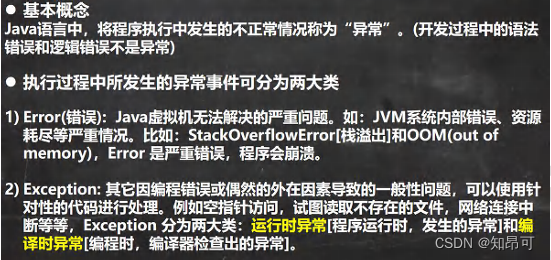
1.2 异常体系图一览

小结:
1. 异常分为两大类,运行时异常和编译时异常·
2. 运行时异常,编译器检查不出来。一般是指编程时的逻辑错误,是程序员应该避免其出现的异常。java.lang.RuntimeException类及它的子类都是运行时异常
3. 对于运行时异常,可以不作处理,因为这类异常很普遍,若全处理可能会对程序的可读性和运行效率产生影响
4. 编译时异常,是编译器要求必须处置的异常。
1.3 常见的运行时异常
1) NullPointerException 空指针异常
2) ArithmeticException 数学运算异常
3) ArrayIndexOutOfBoundsException 数组下标越界异常
4) ClassCastException 类型转换异常
5) NumberFormatException 数字格式不正确异常[]
1.4 举例
1.4.1 NullPointerException 空指针异常
当应用程序试图在需要对象的地方使用 null 时,抛出该异常
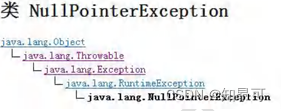
代码:
package com.zakedu.exception_;
/**
* @author
*@version1.0
*/
public class NullPointerException_{
public static void main(String[]args){
String name = null;
System.out.println(name.length());
} }1.4.2 ArithmeticException数学运算异常
当出现异常的运算条件时,抛出此异常。例如,一个整数“除以零”时,抛出此类的一个实例,

代码:
package com.zakedu.exception_;
/**
*@author
*@version1.0
*/
public class NumberFormatException_{
public static void main(String[]args){
String name="zak";
//将String转成int
int num = Integer.parseInt(name);//抛出NumberFormatException
System.out.println(num);//1234
} }
1.4.3 ArrayIndexOutOfBoundsException数组下标越界异常
用非法索引访问数组时抛出的异常。如果索引为负或大于等于数组大小,则该索引为非法索引

代码:
package com.zakedu.exception_;
/**
*@author
*@version1.0
*/
public class ArrayIndexOutOfBoundsException_{
public static void main(String[]args){
int[] arr = {1,2,4};
for(int i = 0; i< = arr.length; i++){
System.out.println(arr[i]);
}
1.4.4 ClassCastException类型转换异常
当试图将对象强制转换为不是实例的子类时,抛出该异常。

代码:
package com.zakedu.exception_;
/**
*@author
*@version1.0
*/
public class ClassCastException_{
public static void main(String[]args){
A b = new B();//向上转型
B b2 =(B)b;//向下转型,这里是OK
C c2 =(C)b;//这里抛出ClassCastException
} }
classA{ }
class B extends A{ }
class C extends A{ }1.4.5 NumberFormatException数字格式不正确异常
当应用程序试图将字符串转换成一种数值类型,但该字符串不能转换为适当格式时,抛出该异常=>使用异常我们 可以确保输入是满足条件数字.

代码:
package com.zakedu.exception_;
/**
*@author
*@version1.0
*/
public class NumberFormatException_{
public static void main(String[]args){
String name="zak";
//将String转成int
int num = Integer.parseInt(name);//抛出NumberFormatException
System.out.println(num);//1234
} }1.5 编译异常
介绍:编译异常是指在编译期间,就必须处理的异常,否则代码不能通过编译。
常见的编译异常:

案例代码:
package com.zakedu.exception_;
import java.io.FileInputStream;
import java.io.IOException;
/**
*@author
*@version1.0
*/
public class Exception02{
public static void main(String[]args){
try{
FileInputStream fis;
fis = new FileInputStream("d:\\aa.jpg");
int len;
while ((len = fis.read()) !=-1) {
System.out.println(len);
}
fis.close();
} catch (IOException e) {
e.printStackTrace();
} } }1.6 异常处理
基本介绍:异常处理就是当异常发生时,对异常处理的方式。
异常处理的方式:

示意图:

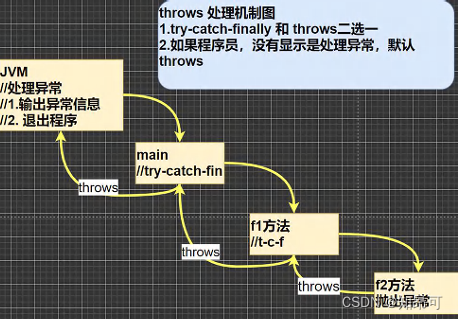
1.7 try-catch异常处理
1.7.1 try-catch 方式处理异常说明:
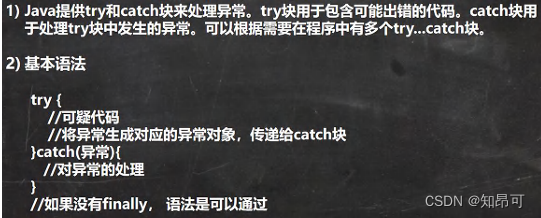
代码:
public static void main(String[] args) {
int num1 =10;
int num2 =0;
try{
int res = num1 / num2;
} catch(Exceptione){
System.out.println(e.getMessage());
} }try-catch方式处理异常-注意事项:
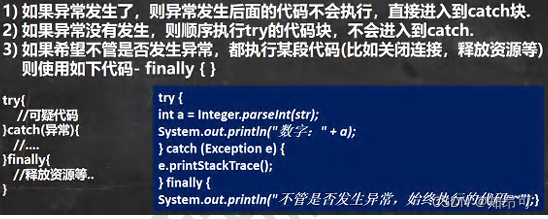
代码:
package com.zakedu.try_;
/**
*@author
*@version1.0
*/
public class TryCatchDetail {
public static void main(String[] args) {
//解读
//1. 如果异常发生了,则异常发生后面的代码不会执行,直接进入到catch块
//2. 如果异常没有发生,则顺序执行try的代码块,不会进入到catch
//3. 如果希望不管是否发生异常,都执行某段代码(比如关闭连接,释放资源等)则使用如下代码-finally
try {
String str = "zak";
int a = Integer.parseInt(str);
System.out.println("数字:" + a);
} catch (NumberFormatException e) {
System.out.println("异常信息=" + e.getMessage());
} finally {
System.out.println("finally 代码块被执行...");
}
System.out.println("程序继续...");
} }
代码:
package com.zakedu.try_;
/**
* @author
* @version 1.0
*/
public class TryCatchDetail02 {
public static void main(String[] args) {
//解读
//1.如果 try 代码块有可能有多个异常
//2.可以使用多个catch 分别捕获不同的异常,相应处理
//3.要求子类异常写在前面,父类异常写在后面
try {
Person person = new Person();
//person = null;
int n1 = 10;
System.out.println(person.getName());//NullPointerException
int n2 = 0;
int res = n1 / n2; //ArithmeticException
} catch (NullPointerException e) {
System.out.println("空指针异常=" + e.getMessage());
} catch (ArithmeticException e) {
System.out.println("算术异常=" + e.getMessage());
} catch (Exception e) {
System.out.println(e.getMessage());
} finally {
} } }
class Person {
private String name = "jack";
public String getName() {
return name;
} }
代码:
package com.zakedu.try_;
/**
* @author
* @version 1.0
*/
public class TryCatchDetail03 {
public static void main(String[] args) {
/*
可以进行 try-finally 配合使用, 这种用法相当于没有捕获异常,
因此程序会直接崩掉/退出。应用场景,就是执行一段代码,不管是否发生异常,
都必须执行某个业务逻辑
*/
try{
int n1 = 10;
int n2 = 0;
System.out.println(n1 / n2);
}finally {
System.out.println("执行了 finally..");
}
System.out.println("程序继续执行..");
} }1.7.2 try-catch-finally 执行顺序小结

1.7.3 练习题
如果用户输入的不是一个整数,就提示他反复输入,直到输入一个整数为止
代码:
package com.zakedu.try_;
import java.util.Scanner;
/**
* @author
* @version 1.0
*/
public class TryCatchExercise04 {
public static void main(String[] args) {
//如果用户输入的不是一个整数,就提示他反复输入,直到输入一个整数为止
//思路
//1. 创建Scanner 对象
//2. 使用无限循环,去接收一个输入
//3. 然后将该输入的值,转成一个int
//4. 如果在转换时,抛出异常,说明输入的内容不是一个可以转成int的内容
//5. 如果没有抛出异常,则break 该循环
Scanner scanner = new Scanner(System.in);
int num = 0;
String inputStr = "";
while (true) {
System.out.println("请输入一个整数:"); //
inputStr = scanner.next();
try {
num =Integer.parseInt(inputStr); //这里是可能抛出异常
break;
} catch (NumberFormatException e) {
System.out.println("你输入的不是一个整数:");
} }
System.out.println("你输入的值是=" + num);
} }1.8 throws 异常处理
1.8.1 介绍

入门案例:

1.8.2 注意事项
1) 对于编译异常,程序中必须处理,比如try-catch或者throws
2) 对于运行时异常,程序中如果没有处理,默认就是throws的方式处理
3) 子类重写父类的方法时,对抛出异常的规定:子类重写的方法。所抛出的异常类型要么和父类抛出的异常一致,要么为父类抛出的异常的类型的子类型
4) 在throws 过程中,如果有方法 try-catch,就相当于处理异常,就可以不必throws
代码:
package com.zakedu.throws_;
import java.io.FileInputStream;
import java.io.FileNotFoundException;
/**
*@author
*@version1.0
*/
public class ThrowsDetail{
public static void main(String[]args){
f2();
}
public static void f2()/*throwsArithmeticException*/{
//1.对于编译异常,程序中必须处理,比如try-catch或者throws
//2.对于运行时异常,程序中如果没有处理,默认就是throws的方式处理
int n1=10;
int n2=0;
double res = n1/n2;
}
public static void f1() throws FileNotFoundException {
//这里大家思考问题 调用f3() 报错
//解读
//1. 因为f3() 方法抛出的是一个编译异常
//2. 即这时,就要f1() 必须处理这个编译异常
//3. 在 f1() 中,要么 try-catch-finally ,或者继续 throws 这个编译异常
f3(); // 抛出异常
}
public static void f3() throws FileNotFoundException {
FileInputStream fis = new FileInputStream("d://aa.txt");
}
public static void f4() {
//解读:
//1. 在 f4()中调用方法f5() 是OK
//2. 原因是f5() 抛出的是运行异常
f5();
}
//3. 而 java 中,并不要求程序员显示处理,因为有默认处理机制
public static void f5() throws ArithmeticException {
} }
class Father { //父类
public void method() throws RuntimeException {
} }
class Son extends Father {//子类
//3. 子类重写父类的方法时,对抛出异常的规定:子类重写的方法,
//所抛出的异常类型要么和父类抛出的异常一致,要么为父类抛出的异常类型的子类型
//4. 在 throws 过程中,如果有方法 try-catch, 就相当于处理异常,就可以不必throws
@Override
public void method() throws ArithmeticException {
} }1.9 自定义异常
基本概念:
当程序中出现了某些“错误”,但该错误信息并没有在Throwable子类中描述处理,这个时候可以自己设计异常类,用于描述该错误信息。
自定义异常的步骤:

自定义异常的应用实例:
题:当我们接收Person对象年龄时,要求范围在18-120之间,否则抛出一个自定义异常(要求继承RuntimeException),并给出提示信息
代码:
package com.zakedu.customexception_;
/**
* @author
* @version 1.0
*/
public class CustomException {
public static void main(String[] args) /*throws AgeException*/ {
int age = 180;
//要求范围在 18–120 之间,否则抛出一个自定义异常
if(!(age >= 18 && age <= 120)) {
//这里我们可以通过构造器,设置信息
throw newAgeException("年龄需要在 18~120 之间");
}
System.out.println("你的年龄范围正确.");
} }
//自定义一个异常
//解读
//1. 一般情况下,我们自定义异常是继承 RuntimeException
//2. 即把自定义异常做成 运行时异常,好处时,我们可以使用默认的处理机制
//3. 即比较方便
class AgeException extends RuntimeException {
public AgeException(String message) {//构造器
super(message);
} }1.10 throw 和 throws 的区别
一览表:























 2265
2265











 被折叠的 条评论
为什么被折叠?
被折叠的 条评论
为什么被折叠?








